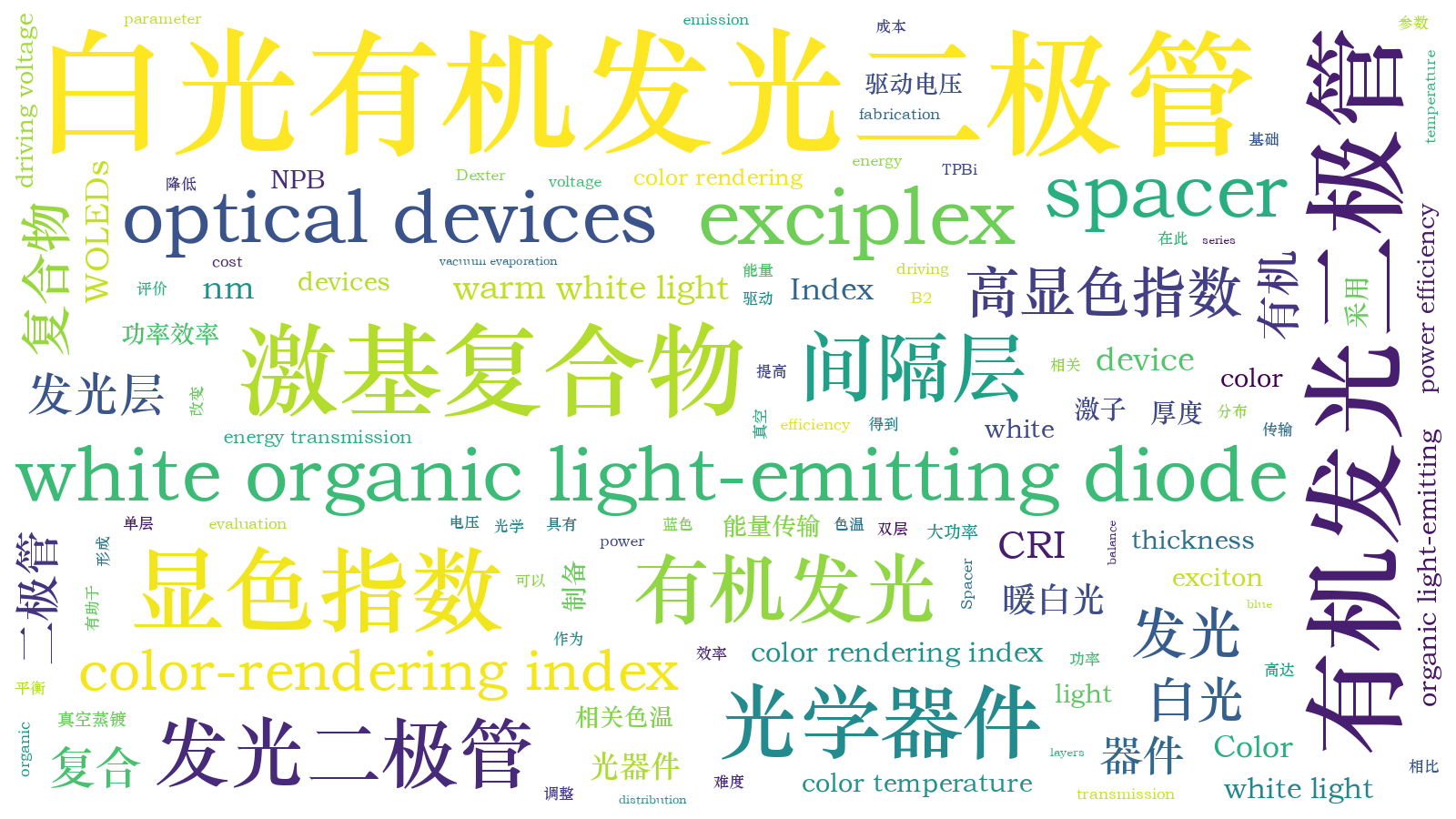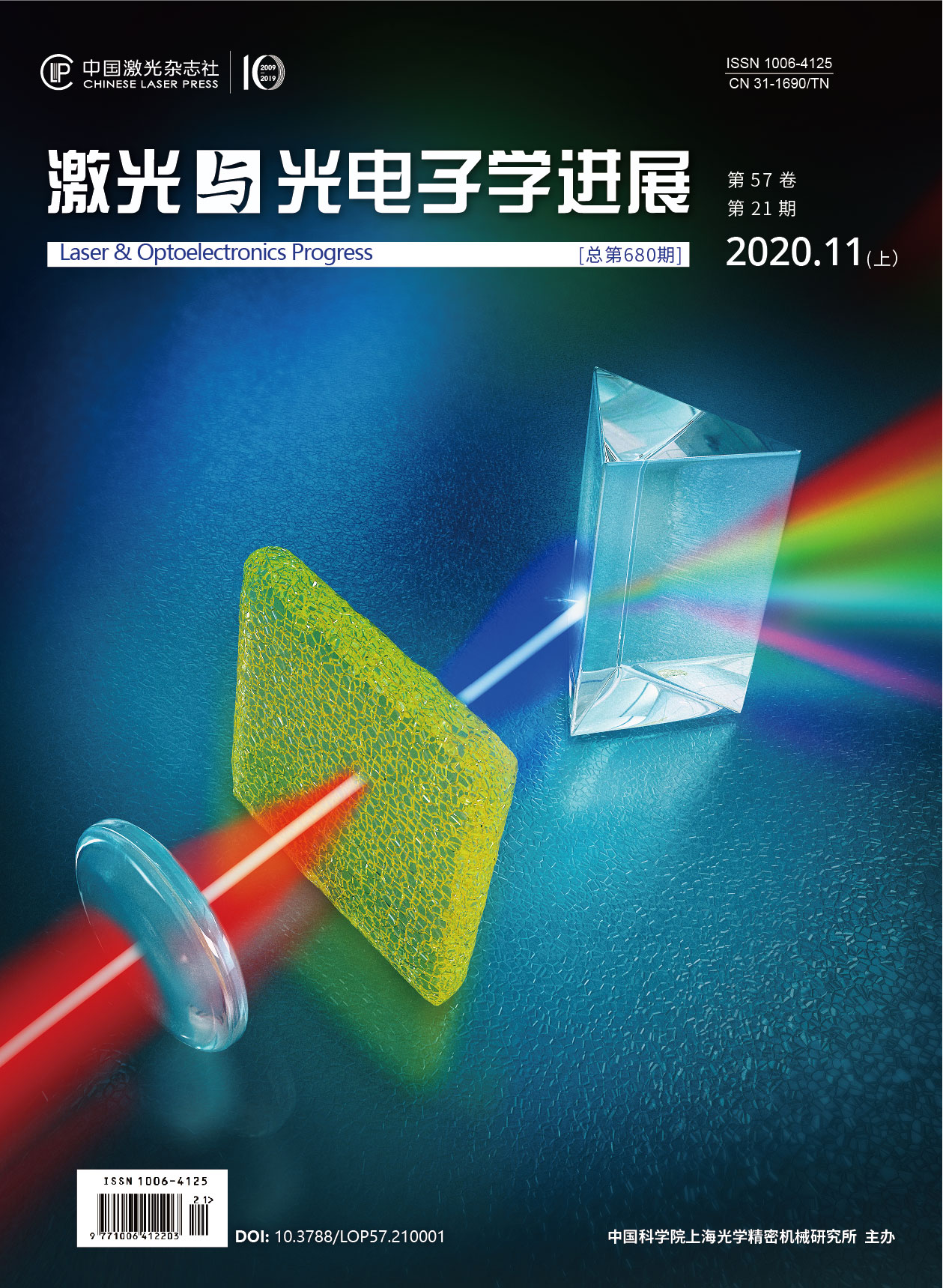基于激基复合物的高显色指数白光有机发光二极管  下载: 1071次
下载: 1071次
1 引言
白光有机发光二极管(WOLED)以其高显色指数(CRI)、高亮度、自发光、可柔性和宽视角等优点,被称为新一代显示技术,在固态照明和平板显示器上具有巨大的应用潜力[1-6]。对于WOLED而言,显色指数、相关色温(CCT)和色坐标CIE(x,y)是三个重要的发光输出特性,其中显色指数是评估器件性能的重要参数。在需要精确对比色彩的照明场所,显色指数需要高于90。随着人们对有机发光二极管(OLED)研究的深入,如何获得高的显色指数成为当前的研究热点[7-8]。考虑到单个发光层的光谱带宽有限,为完全覆盖整个可见光谱,人们通常将多个发光层结合起来,以获得较高的显色指数[9-12]。Luo等[13]在三色器件中使用m-MTDATA作为间隔层,在亮度为1000 cd/m2时获得了显色指数为85、相关色温为2376 K的白光器件。Yu等[14]将TCTA∶Tm3PyPB作为四色磷光超薄层的间隔层制作白光器件,最优化白光器件在7 V电压时的显色指数为77.4。该白光器件的显色指数不够高,难以满足实际应用要求。Zhang等[15]采用CBP隔离磷光材料和荧光材料制作了白光器件,该器件在亮度为1000 cd/m2时的显色指数为92,相关色温低于2500 K。Miao等[16]利用蓝色荧光材料Beep2作为磷光材料的间隔层制作了暖白光器件,该器件在9 V电压时的显色指数大于90,相关色温为2468 K。以上器件的显色指数均较高,但磷光和荧光的混合发光机制使得器件的结构更加复杂,不利于批量化生产。
本文采用激基复合物(NPB∶TPBi)替代价格高昂的磷光材料制作了单层激基复合物结构和双层激基复合物结构器件,研究了激子分布对白光器件显色指数的影响。本文发现,对间隔层(TCTA)厚度进行调制,可以管理激子的Dexter能量传输,简化器件的结构。
2 实验简介
本文使用方昇光电股份有限公司生产的OMV-FS300型有机-金属真空蒸发镀膜设备进行OLED器件的制备。实验中所有的器件都是在真空度低于5×10-5 Pa的腔体压力下制备的,所用基底均为镀有氧化铟锡(ITO)薄膜的玻璃基板,其表面方阻为15 Ω/sq。玻璃基板在使用前依次在洗涤剂、去离子水、异丙醇中超声清洗15 min。所有有机材料均以0.01~0.1 nm/s的速率沉积在基板上,金属阴极以0.3 nm/s的速率沉积。沉积速率和膜厚由石英晶体振荡器监控。电致发光(EL)光谱和亮度特性采用PR655光谱仪进行测量。利用Keithley 2400数字电源提供电压信号,测量并记录电压和电流数据。
本实验所用材料的能级图如
器件结构如
3 分析与讨论
本文首先制备了基于单层激基复合物的器件A1和基于双层激基复合物的器件A2。
器件A1的结构为:ITO (100 nm)/HAT-CN (10 nm)/TAPC (40 nm)/NPB∶TPBi (x nm, x=0)/Ir(piq)2(acac) (0.15 nm)/TCTA (3 nm)/PO-01 (0.1 nm)/TCTA (3 nm)/Ir(ppy)3 (0.1 nm)/NPB∶TPBi (3-x nm)/TmPyPB (40 nm)/Liq (2 nm)/Al (100 nm)。
器件A2的结构为:ITO (100 nm)/HAT-CN (10 nm)/TAPC (40 nm)/NPB∶TPBi (x nm, x=1.5)/Ir(piq)2(acac) (0.15 nm)/TCTA (y nm, y=3)/PO-01 (0.1 nm)/TCTA (3 nm)/Ir(ppy)3 (0.1 nm)/NPB∶TPBi (3-x nm)/TmPyPB (40 nm)/Liq (2 nm)/Al (100 nm)。
表 1. 不同结构器件的电致发光特性
Table 1. Electroluminescence characteristics of different devices
|

图 3. 不同器件的性能曲线。(a)亮度-电压-电流密度曲线;(b)功率效率-电流密度-电流效率曲线图
Fig. 3. Property curves of different devices. (a) Luminance-voltage-current density curves; (b) power efficiency-current density-current efficiency curves
器件A1的红、黄、蓝和绿色发射峰强度与器件A2有所差别。相对较高的红色发射峰强度更有助于提高亮度。因此,器件A1的效率虽然较高,但其亮度并不高。另外,器件A1的显色指数为64,器件A2的显色指数为69,这说明双层激基复合物的结构有利于提高显色指数。

图 4. 器件A1、A2在5 V下的归一化EL光谱
Fig. 4. Normalized EL spectra of devices A1 and A2 at voltage of 5 V

图 5. 不同器件的性能曲线。(a)亮度-电压-电流密度曲线;(b)功率效率-电流密度-电流效率曲线,插图为器件B2在点亮状态下的图片
Fig. 5. Property of different devices. (a) Luminance-voltage-current density curves; (b) power efficiency-current density-current efficiency curves, the inset showing a picture of device B2 in lighted state
随着Spacer 1的厚度减小,电流密度逐渐增大,这说明更薄的间隔层有利于载流子注入。电流密度的变化趋势可以用公式来解释[22],即
式中:J为电流密度;V为驱动电压;μ和d分别为载流子迁移率和整体器件的厚度;
器件A2、B1、B2、B3的功率效率分别为19.88,18.51,16.11,14.76 lm/W。较薄的间隔层会导致大量激子传输到红色发光层,过量的激子聚集在磷光层不仅会发生三重态激子猝灭,并且会降低器件的整体效率[23]。更加平衡的激子分布可提高器件的亮度,如器件B3的亮度从器件A2的3538 cd/m2提高到4100 cd/m2。

图 6. 不同器件在5 V下的归一化EL光谱
Fig. 6. Normalized EL spectra of different devices at voltage of 5 V

图 7. 器件的色坐标x和y随电压的变化
Fig. 7. Variation of CIE x and CIE y coordinates versus voltage for devices
4 结论
采用双层激基复合物结构可以制备出高显色指数的WOLED。本文主要探究了激子分布对白光器件显色指数的影响。采用单层激基复合物结构时,激子多数聚集于复合区,致使传递到绿色、橙色和红色发光层的能量不充分。采用双层激基复合物结构后,激子分布得更加均匀。通过对间隔层TCTA进行调整,有效地促进了三重态激子在发光层之间的传递。最优暖白光器件B2的最大功率效率为16.11 lm/W,在5 V电压下的显色指数可达95,相对色温为2322 K。
使用激基复合物替代传统的蓝色发光层,可以降低生产成本和制备难度,为实现高显色指数(>90)的WOLED提供了一条可行路线。
[1] Zhao Y B, Chen J S, Ma D G. Realization of high efficiency orange and white organic light emitting diodes by introducing an ultra-thin undoped orange emitting layer[J]. Applied Physics Letters, 2011, 99(16): 163303.
[2] Yang F Y, Kou Z Q, Yang L P, et al. Influence of the hole transport layer on spectral stability in the white phosphorescent organic light emitting diode with non-doped structure[J]. Optical Materials, 2018, 82: 130-134.
[3] Schwartz G, Reineke S, Rosenow T C, et al. Triplet harvesting in hybrid white organic light-emitting diodes[J]. Advanced Functional Materials, 2009, 19(9): 1319-1333.
[4] 李真真, 刘伟强, 武瑞霞, 等. 主体材料对绿色有机发光二极管性能的影响[J]. 激光与光电子学进展, 2019, 56(22): 222302.
[5] 林雯嫣, 喻叶, 彭雪康, 等. N掺杂改善黄色磷光有机电致发光器件的效率滚降[J]. 光学学报, 2019, 39(3): 0323001.
[6] 卢小香, 王勇, 韩晓媚, 等. 纳米图形增强OLED出光效率研究[J]. 激光与光电子学进展, 2018, 55(2): 022301.
[7] Sun N, Zhao Y B, Zhao F C, et al. A white organic light-emitting diode with ultra-high color rendering index, high efficiency, and extremely low efficiency roll-off[J]. Applied Physics Letters, 2014, 105(1): 013303.
[8] Li Z Y, Li B W, Wei X F, et al. High efficiency, high color rendering index white organic light-emitting diodes based on thermally activated delayed fluorescence materials[J]. Applied Physics Letters, 2019, 115(26): 263302.
[9] Lee S E, Oh J H, Baek H J, et al. Realization of high-color-quality white-by-blue organic light-emitting diodes with yellow and red phosphor films[J]. Journal of Luminescence, 2019, 207: 195-200.
[10] Wu Z B, Ma D G. Recent advances in white organic light-emitting diodes[J]. Materials Science and Engineering R, 2016, 107: 1-42.
[11] Zhang W, Wu L S, Su Z S, et al. Low color temperature, high color rendering index candlelight style white organic light-emitting devices with a fac-tris (mesityl-2-phenyl-1H-imidazole) iridium (III) blue emitting layer[J]. Materials Research Express, 2018, 6(1): 016205.
[13] Luo D X, Xiao P, Liu B Q. Doping-free white organic light-emitting diodes[J]. The Chemical Record, 2019, 19(8): 1596-1610.
[14] YuH, DaiX, YaoF, et al. Efficient white phosphorescent organic light-emitting diodes using ultrathin emissive layers( <1 nm)[J]. Scientific Reports, 8( 1): 6068.
[15] ZhangT, He SJ, Wang DK, et al. A multi-zoned white organic light-emitting diode with high CRI and low color temperature[J]. Scientific Reports, 6( 1): 20517.
[16] Miao Y Q, Wang K X, Zhao B, et al. High-efficiency/CRI/color stability warm white organic light-emitting diodes by incorporating ultrathin phosphorescence layers in a blue fluorescence layer[J]. Nanophotonics, 2018, 7(1): 295-304.
[17] Liu B Q, Tao H, Wang L, et al. High-performance doping-free hybrid white organic light-emitting diodes: the exploitation of ultrathin emitting nanolayers (<1 nm)[J]. Nano Energy, 2016, 26: 26-36.
[18] Wang B Q, Kou Z Q, Tang Y, et al. High CRI and stable spectra white organic light-emitting diodes with double doped blue emission layers and multiple ultrathin phosphorescent emission layers by adjusting the thickness of spacer layer[J]. Organic Electronics, 2019, 70: 149-154.
[19] Jankus V, Chiang C J, Dias F, et al. Deep blue exciplex organic light-emitting diodes with enhanced efficiency; P-type or E-type triplet conversion to singlet excitons?[J]. Advanced Materials, 2013, 25(10): 1455-1459.
[20] Xue K W, Chen P, Duan Y, et al. Improved color stability of white organic light-emitting diodes without interlayer between red, orange and blue emission layers[J]. Optics Communications, 2016, 362: 59-63.
[21] Zhang H, Yang X, Cheng J, et al. Enhanced color stability for white organic light-emitting diodes based on dual ultra-thin emitting layer[J]. Organic Electronics, 2017, 50: 147-152.
[22] Yun C, Lee J, Lee J, et al. Influence of phosphorescent dopants in organic light-emitting diodes with an organic homojunction[J]. Applied Physics Letters, 2012, 101(24): 243303.
[23] Tan T, Ouyang S H, Xie Y T, et al. Balanced white organic light-emitting diode with non-doped ultra-thin emissive layers based on exciton management[J]. Organic Electronics, 2015, 25: 232-236.
付祥恩, 杨飞宇, 唐宇. 基于激基复合物的高显色指数白光有机发光二极管[J]. 激光与光电子学进展, 2020, 57(21): 212303. Fu Xiang''en, Yang Feiyu, Tang Yu. White Organic Light-Emitting Diodes with High Color-Rendering Index Based on Exciplex[J]. Laser & Optoelectronics Progress, 2020, 57(21): 212303.








